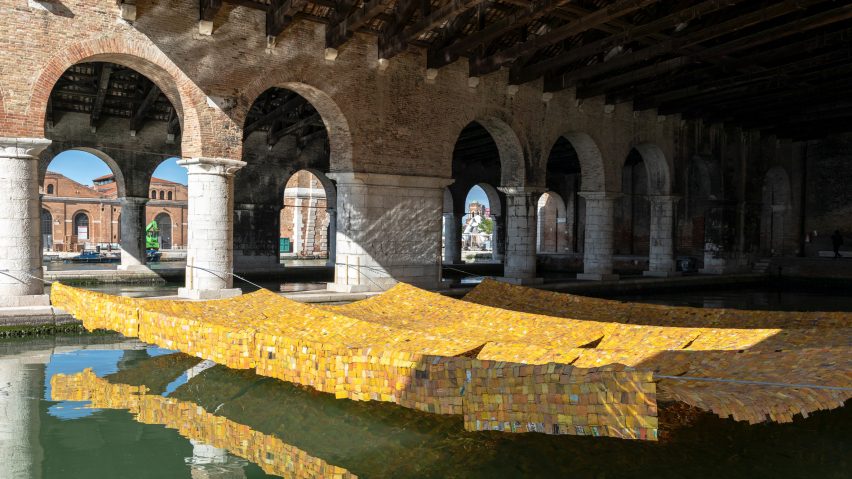This year's Venice Architecture Biennale is now open to the public. In this roundup, we spotlight nine projects from its main exhibition, The Laboratory of the Future.
Curated by architect Lesley Lokko, The Laboratory of the Future includes a number of installations exploring themes of decolonisation and decarbonisation.
Many of these are examined through the lens of Africa, which Lokko has deliberately placed at the heart of the Venice Architecture Biennale for the first time.
"For this exhibition, two keywords shaped practitioners' responses: decarbonisation and decolonisation," Lokko told Dezeen ahead of the opening.
"Africa's unique context, which is both richly challenging and richly creative, means it's a powerful place from which to examine the issues that will dominate the next century – climate change, societal change, demographic change, new forms of governance, explosive urbanity."
Read on for nine projects that encapsulate The Laboratory of the Future.
Investigating Xinjiang's Network of Detention Camps by Killing Architects
This installation by Killing Architects outlines its recent investigation into the network of internment camps in Xinjiang, China, for which its founder Alison Killing won the Pulitzer Prize.
The installation includes a film explaining the process of using architectural and spatial analysis tools, as well as satellite imagery and Chinese prison building regulations to uncover the scale of the network allegedly built by the Chinese government for the detainment of Uyghurs.
Mnemonic by Looty
Product design studio Looty has produced the "world's first digital repatriation of stolen art", on show at The Laboratory of the Future.
Its aim is to make it simpler for the younger generation of Africans to access and study cultural items currently held by museums around the world. The artefacts are digitally recorded, rendered and digitised as non-fungible tokens (NFTs).
"The installation encourages visitors to reflect on the role that technology plays in cultural preservation and on the importance of safeguarding cultural heritage for future generations," Looty said.
The Great Endeavour by Liam Young
Created in collaboration with scientists and technologists, The Great Endeavour is a short film directed by architect Liam Young that imagines the development of new infrastructure to remove carbon from the atmosphere and store it underground to reach climate targets.
"The film captures millions of people on the construction site, in coordinated action to decolonise the atmosphere in our last great act of planetary transformation," said Young.
Time and Chance by Serge Attukwei Clottey
This installation by Ghanaian artist Serge Attukewei Clottey is divided into two parts – an artwork in the main exhibition and a larger, matching structure suspended over the water outside at the Gaggiandree shipyards.
Made of yellow-plastic gallon containers found in Ghana that are cut, drilled and stitched together, the artworks delicately hang with shapes formed by their own weight. According to Clottey, the work aims to investigate global material cultures.
Entity of Decolonization by DAAR
This deconstructed building facade was created by architects Alessandro Petti and Sandi Hilal, the directors of the studio DAAR, to explore the reappropriation of fascist colonial architecture.
The model is a recreation of the main building in the rural settlement of Borgo Rizza, which was built in the 1940s under the fascist regime to modernise Sicily. At the time, Italy was governed by the Benito Mussolini-led National Fascist Party. Similar masterplans were simultaneously adopted in the colonial masterplans for places including Libya and Somalia.
DAAR won the Golden Lion for the best participant in The Laboratory of the Future exhibition.
Griot by Studio Barnes
Studio Barnes' contribution to Laboratory of the Future is a series of physical objects and drawings that aim to tell the history of the African diaspora through the lens of architecture, identity and colonisation.
"Griot demands a reorientation of foundational principles, providing the opportunity to reimagine a new future," said Studio Barnes. "One that positions Africa and its descendants as a force to be acknowledged and revered."
Embodiments: Port of Sihr – Final Act by Gugulethu Sibonelelo Mthembu
Architect Gugulethu Sibonelelo Mthembu spotlights female oppression and representation in Africa in her exhibit.
Specifically, it focuses on the story of Aicha Qandisha – a shapeshifting female spirit that is said to appear in men's dreams and lead them to infidelity. In folklore, this spirit is blamed for the actions of men, but Mthembu's exhibition aims to create a new story for her.
Liminality by Neri&Hu
Chinese architecture studio Neri&Hu is exhibiting Liminality, a showcase of three of its adaptive reuse projects that explore the concept of liminal space. According to the studio, it aims to create a zone between "design practice and theoretical exploration".
"As we imagine for ourselves what the future holds, we collectively occupy the liminal space of experimentation both in theoretical constructs and in design practice," the studio said. "Liminal space and the notion of the threshold represent a space of ambiguity that engenders new possibilities and change."
Bengali Song by Arinjoy Sen
Architectural designer Arinjoy Sen created this triptych of tapestries with marginalised artisans in Bengal represented by She Kantha – a non-governmental organisation focused on reviving the traditional embroidery craft Kantha.
The work depicts different uses of Khudi Bari, a quick-to-assemble, modular house adaptable to various contexts designed by Bangladeshi architect Marina Tabassum. These include a refugee camp and a coastal floodplain.
The triptych was crafted by the artisans from a digital drawing, and aims to position "the architect as giving voice to marginalised peoples", Sen said.
The main photo is by Andrea Avezzù.
The Venice Architecture Biennale takes place from 20 May to 26 November 2023. See Dezeen Events Guide for all the latest information you need to know to attend the event, as well as a list of other architecture and design events taking place around the world.

